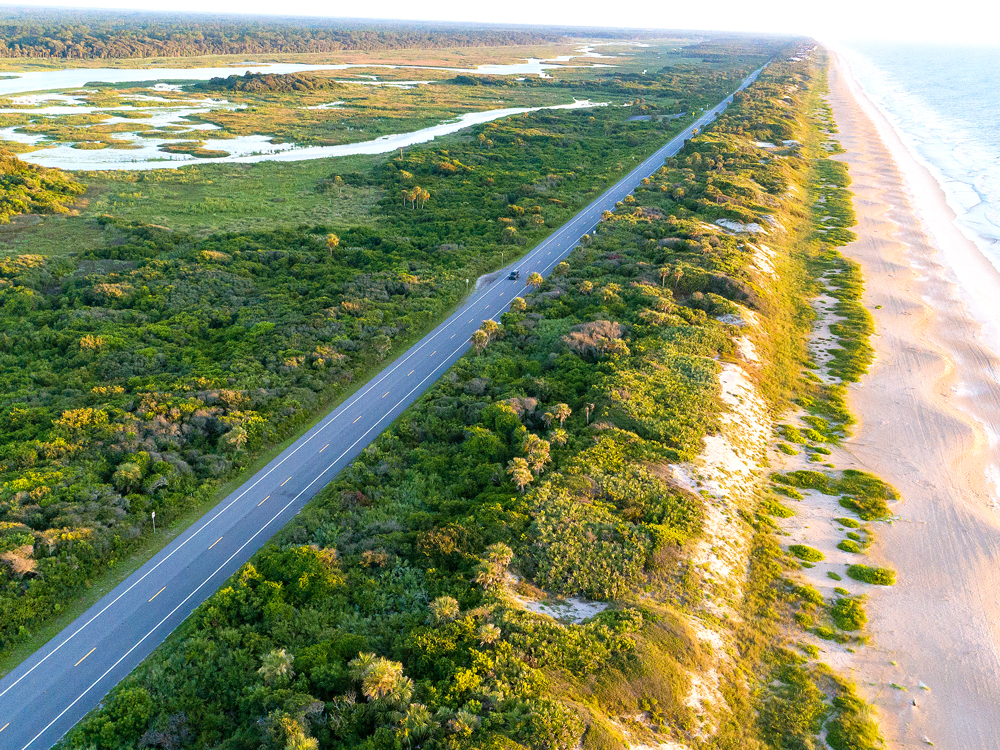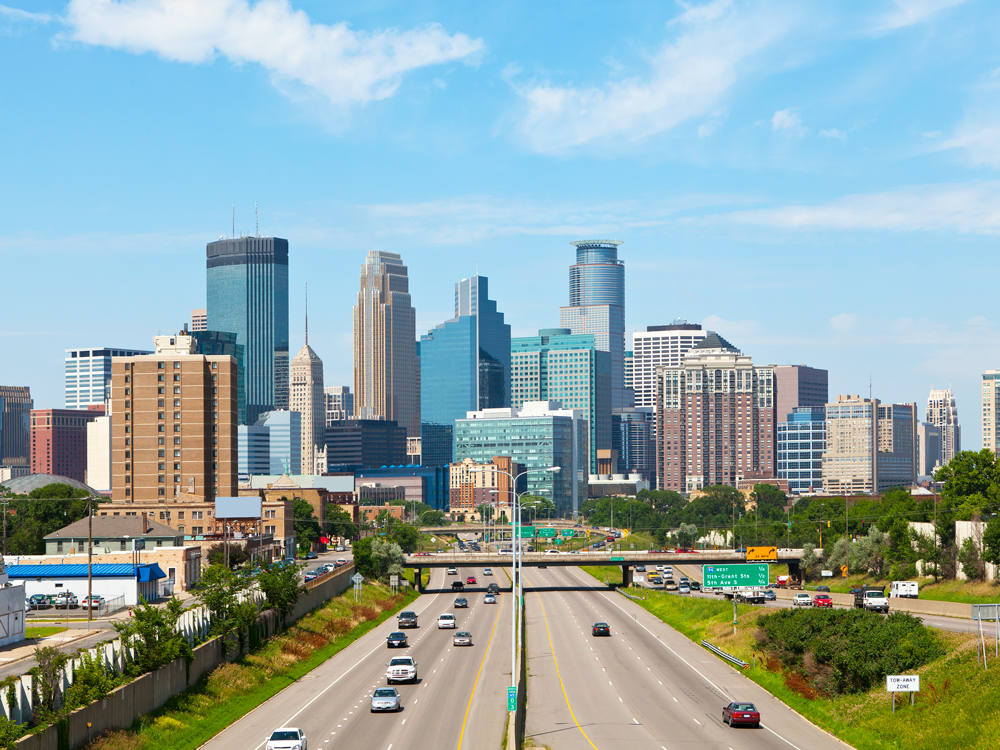Planning the perfect road trip can be an overwhelming task — after all, there are so many potential routes that you can take. But what if you just let the weather dictate where you traveled to? According to Brian Brettschneider, a climate scientist in Anchorage, Alaska, it’s possible to plan a road trip where the average temperature hovers around a balmy 70 degrees Fahrenheit the entire time. So forget about stuffing your suitcase with both bulky winter jackets and flip-flops to prepare for every kind of weather — all you’ll need is a light, comfortable outfit if you follow this guide. Discover the U.S. road trips that you can take to almost guarantee perfect weather the entire route. (Just be sure to follow these road trip safety tips along the way.)
The Coastal Route

In 2015, Brettschneider calculated a series of perfect road trip routes based on daily normal high temperatures across the country. In 2023, he released updated routes based on new climate data provided by the National Centers for Environmental Information (NCEI). Brettschneider plotted out three, year-long road trip routes. Though they begin in January and go all the way through December, there’s no requirement to commit to the entire year — you can hop along the route for as long as you like, depending on where you are in the country and what time of year it is.
First up is the Coastal Route, which takes travelers all the way from Florida, up along the Eastern Seaboard, and then counterclockwise over to the Pacific Northwest, before finally heading south toward San Diego. This entire route covers a total driving distance of 7,468 miles.
The journey begins in January with a brief 151-mile-long excursion from Tampa, Florida, to nearby Orlando. In February, you’ll drive just 81 miles to Jacksonville, staying in Florida the entire time. March is where the road trip picks up, as you’ll drive 341 miles north through Georgia and South Carolina before crossing over the border into North Carolina.
As springtime blossoms, the route continues for 447 miles up to Philadelphia in April, followed by a 300-mile trek up to Boston, Massachusetts, in May. June is when things accelerate fast: Start by heading to Buffalo, New York, drop down along the Great Lakes to Cleveland, Ohio, then make your way to Detroit, Michigan. Once in Michigan, head up toward the Upper Peninsula and then cut across several states over to north-central Montana, for a total of 2,388 miles.
Amid the sweltering heat of July, you’ll continue toward the cooler Pacific Northwest for 965 miles, taking you through the remainder of Montana, through Idaho, and then to Seattle, Washington. In August, you’ll head down the Pacific coast toward Newport, Oregon, spanning a distance of 289 miles. September’s total road trip distance is 962 miles — during which you’ll cut back across Oregon, through southern Idaho, and down to southern Utah.
In October, drive 546 miles down through Utah, briefly cut into Arizona, then head over to Albuquerque, New Mexico. In November, begin your 467-mile trek by cutting back westward on Interstate 40 toward Flagstaff, Arizona, before heading to Phoenix to end the month. Finally, spend December driving 531 miles from Phoenix over to Los Angeles, before driving down the coast to end your journey in San Diego.
The Interior Route

The Interior Route may not offer the same scenic ocean views as the Coastal Route, but the weather should be just as pleasant along the 7,064-mile trek. Your road trip will begin in Bronxville, Texas, as you spend January driving 140 miles over to Corpus Christi. In February, head 197 miles northeast toward Houston. In March, continue toward Dallas and then catch Interstate 35 up to Oklahoma City, where you’ll finish 408 miles of driving.
As the weather begins to warm in the spring, spend April driving 343 miles across Kansas before ending up in Kansas City. Then, in May, you’ll drive 765 miles through Missouri, Iowa, Illinois, and Wisconsin, before ending the month in Minneapolis. As June comes around, you’ll drive north from Minneapolis to Duluth before cutting east toward central Montana — 923 of these miles will be identical to the Coastal Route.
As you’ve reached July, you’ll beat the heat during your 1,255-mile trip during the month. Begin by heading toward Butte, Montana, then pass through the stunning Yellowstone National Park in Wyoming. Continue on toward northwestern Colorado, before heading back up to south-central Wyoming where the temperatures aren’t so hot. You’ll end the summer by driving 384 miles in August through Wyoming and back into southern Montana.
In September, make your way out of Montana toward the southwestern corner of North Dakota before dipping down to northwestern Nebraska, covering a total driving distance of 533 miles. In October, your journey begins with a 1,047-mile drive toward northern Texas, where temperatures have finally begun to wane, before cutting over to Cloudcroft, New Mexico. Then, you’ll travel an additional 399 miles in November over to Phoenix, Arizona. Come December, you’ll end your trip with a 531-mile journey down to San Diego, just like the Coastal Route.
The Combined Route

If you’d like to do a little bit of both of the aforementioned routes, then consider embarking upon the Combined Route, an 8,466-mile-long route across the country. January and February will be identical to the Interior Route, taking you through various parts of Texas. Come March, you’ll head toward Little Rock, Arkansas, instead of toward Oklahoma City. In April, drive 1,128 miles through Memphis and Nashville, Tennessee, before finishing the month in Washington, D.C. From this point on, your journey will follow the same path as the Coastal Route.
The Route That Includes Canada and Alaska

Feeling really ambitious? Then this 13,909-mile-long journey through Canada, Alaska, and back is the route for you.
Interestingly, this road trip begins where the others end: San Diego. Start off January by heading 357 miles along Interstate 8 from San Diego to Phoenix, Arizona, where you’ll finish off the month. In February, follow I-10 for 384 miles down to El Paso, Texas. Come March, you’ll cover 991 miles toward Wichita Falls, Texas, before ending up in western Oklahoma.
In April, drive 1,328 miles through Arkansas, Tennessee, North Carolina, Virginia, and West Virginia, before ending the month in Pittsburgh, Pennsylvania. Then, in May, drive 1,440 miles toward central Pennsylvania, then back west through Ohio, Indiana, Illinois, Wisconsin, and finally Minnesota.
June is where this route becomes particularly ambitious — you’ll drive 3,424 across the Canadian border and into Alaska. Begin by crossing the border at International Falls, Minnesota, then head up toward Longbow Lake, Ontario. Once in Canada, cut over through Winnipeg, Manitoba, and Edmonton, Alberta, before heading north toward the town of Dawson in the Yukon. To end June, cross over into Alaska before finishing the month in Fairbanks.
In July, you’ll begin a 1,735-mile trek by heading toward Anchorage before cutting back into Canada and ending the month in Prince George, British Columbia. You’ll finally return to the lower 48 in August, driving 643 miles over to Calgary, Alberta, before crossing the border back into Glacier National Park in Montana.
The final leg of your road trip will begin in September, as you drive 1,056 miles through Montana, Idaho, and Utah, before crossing just over the Utah-Colorado border. Then, in October, drive 1,632 miles through Colorado, into northern New Mexico, then back north through Kansas, before winding up back in Little Rock Arkansas.
Come November, you’ll drive 732 miles through Jackson, Mississippi, and Birmingham, Alabama, before ending up in Lake City, Florida. For the final leg of your epic road trip in December, you’ll finish the journey off with a 187-mile-long drive down to the sunny town of Daytona, Florida.
More from our network
Daily Passport is part of Inbox Studio, which publishes content that uplifts, informs, and inspires.
















